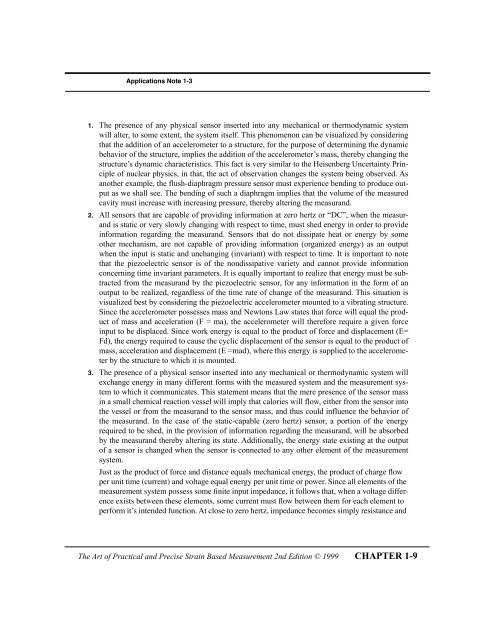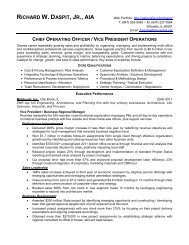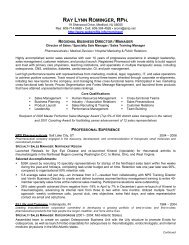The Art of Practical and Precise Strain Based ... - Webprofile.info
The Art of Practical and Precise Strain Based ... - Webprofile.info
The Art of Practical and Precise Strain Based ... - Webprofile.info
- No tags were found...
Create successful ePaper yourself
Turn your PDF publications into a flip-book with our unique Google optimized e-Paper software.
Applications Note 1-31. <strong>The</strong> presence <strong>of</strong> any physical sensor inserted into any mechanical or thermodynamic systemwill alter, to some extent, the system itself. This phenomenon can be visualized by consideringthat the addition <strong>of</strong> an accelerometer to a structure, for the purpose <strong>of</strong> determining the dynamicbehavior <strong>of</strong> the structure, implies the addition <strong>of</strong> the accelerometerÕs mass, thereby changing thestructureÕs dynamic characteristics. This fact is very similar to the Heisenberg Uncertainty Principle<strong>of</strong> nuclear physics, in that, the act <strong>of</strong> observation changes the system being observed. Asanother example, the flush-diaphragm pressure sensor must experience bending to produce outputas we shall see. <strong>The</strong> bending <strong>of</strong> such a diaphragm implies that the volume <strong>of</strong> the measuredcavity must increase with increasing pressure, thereby altering the measur<strong>and</strong>.2. All sensors that are capable <strong>of</strong> providing <strong>info</strong>rmation at zero hertz or ÒDCÓ, when the measur<strong>and</strong>is static or very slowly changing with respect to time, must shed energy in order to provide<strong>info</strong>rmation regarding the measur<strong>and</strong>. Sensors that do not dissipate heat or energy by someother mechanism, are not capable <strong>of</strong> providing <strong>info</strong>rmation (organized energy) as an outputwhen the input is static <strong>and</strong> unchanging (invariant) with respect to time. It is important to notethat the piezoelectric sensor is <strong>of</strong> the nondissipative variety <strong>and</strong> cannot provide <strong>info</strong>rmationconcerning time invariant parameters. It is equally important to realize that energy must be subtractedfrom the measur<strong>and</strong> by the piezoelectric sensor, for any <strong>info</strong>rmation in the form <strong>of</strong> anoutput to be realized, regardless <strong>of</strong> the time rate <strong>of</strong> change <strong>of</strong> the measur<strong>and</strong>. This situation isvisualized best by considering the piezoelectric accelerometer mounted to a vibrating structure.Since the accelerometer possesses mass <strong>and</strong> Newtons Law states that force will equal the product<strong>of</strong> mass <strong>and</strong> acceleration (F = ma), the accelerometer will therefore require a given forceinput to be displaced. Since work energy is equal to the product <strong>of</strong> force <strong>and</strong> displacement (E=Fd), the energy required to cause the cyclic displacement <strong>of</strong> the sensor is equal to the product <strong>of</strong>mass, acceleration <strong>and</strong> displacement (E =mad), where this energy is supplied to the accelerometerby the structure to which it is mounted.3. <strong>The</strong> presence <strong>of</strong> a physical sensor inserted into any mechanical or thermodynamic system willexchange energy in many different forms with the measured system <strong>and</strong> the measurement systemto which it communicates. This statement means that the mere presence <strong>of</strong> the sensor massin a small chemical reaction vessel will imply that calories will flow, either from the sensor intothe vessel or from the measur<strong>and</strong> to the sensor mass, <strong>and</strong> thus could influence the behavior <strong>of</strong>the measur<strong>and</strong>. In the case <strong>of</strong> the static-capable (zero hertz) sensor, a portion <strong>of</strong> the energyrequired to be shed, in the provision <strong>of</strong> <strong>info</strong>rmation regarding the measur<strong>and</strong>, will be absorbedby the measur<strong>and</strong> thereby altering its state. Additionally, the energy state existing at the output<strong>of</strong> a sensor is changed when the sensor is connected to any other element <strong>of</strong> the measurementsystem.Just as the product <strong>of</strong> force <strong>and</strong> distance equals mechanical energy, the product <strong>of</strong> charge ßowper unit time (current) <strong>and</strong> voltage equal energy per unit time or power. Since all elements <strong>of</strong> themeasurement system possess some Þnite input impedance, it follows that, when a voltage differenceexists between these elements, some current must ßow between them for each element toperform itÕs intended function. At close to zero hertz, impedance becomes simply resistance <strong>and</strong><strong>The</strong> <strong>Art</strong> <strong>of</strong> <strong>Practical</strong> <strong>and</strong> <strong>Precise</strong> <strong>Strain</strong> <strong>Based</strong> Measurement 2nd Edition © 1999 CHAPTER 1-9
















